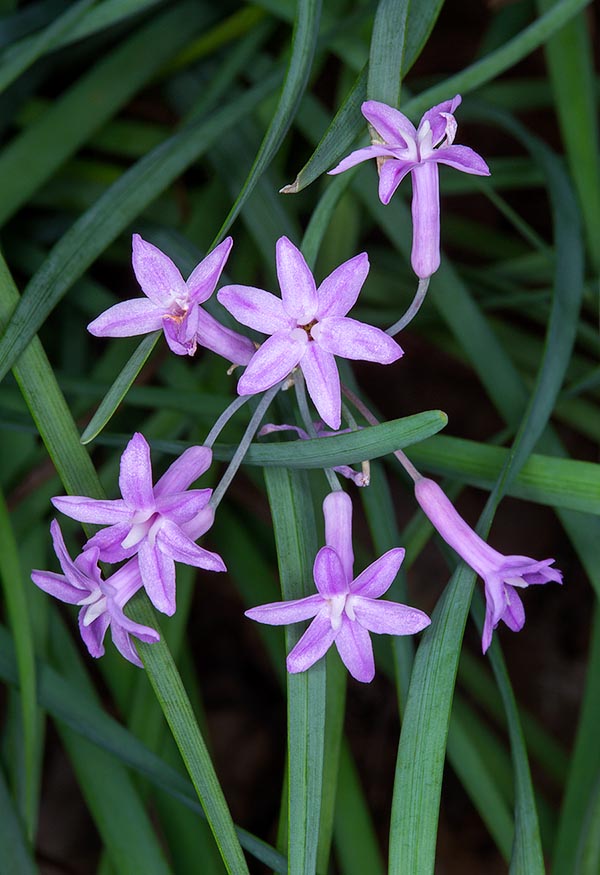Family : Amaryllidaceae

Text © Pietro Puccio

English translation by Mario Beltramini
The species is native to South Africa (Eastern Cape, KwaZulu-Natal, Northern Cape and Western Cape) where it grows in prairies on rocky soils.
The genus was dedicated by Linnaeus to the Dutch governor of the Cape Colony, Ryik Tulbagh (1699-1771), who had sent him various specimens of the local flora; the specific name is the Latin adjective “violaceous, a, um” = violaceous, with obvious reference.
Common names: pink agapanthus, society garlic, sweet garlic, wild garlic (English); wildeknoflok, noffel (Afrikaans); utswelane (IsiXhosa); isihaqa (Zulu).

Tulbaghia violacea is a South African rhizomatous. Ornamental species with incredible medicinal virtues © Giuseppe Mazza
Erect floral scape from the centre of the rosette, 30-65 cm long, ending in an umbel inflorescence, initially enclosed in a spathe formed by two ovate-lanceolate membranaceous valves, carrying 8-20 lilac flowers, pleasantly perfumed, that open gradually.
Flowers, on a 1-2 cm long pedicel, with perianth in two verticils united to form a tube, 1-1,2 cm long, ending with 3 outer and 3 inner lobes, elliptic with obtuse apex, 6-8 mm long and 2-3 mm broad, 6 stamens, of which 3 at the apex of the tube and 3 inside, trilocular ovary and 1-2 mm long style. The fruit is a trigonal capsule containing numerous oblong seeds, flat, of black colour; it selfdisseminates easily.
It reproduces by seed in draining loam maintained humid, but without stagnations, at the temperature of 22-24 °C, with germination times of 2-4 weeks and first blooming after 2-3 years, and easily by division in winter-spring.
Species with long lasting blooming in summer-autumn that requires little care, utilizable for flower beds, borders, even mixed, and rocky gardens in an ample variety of climates, bearing high values of temperature as well as low, up to -12 °C at level of rhizome, and of soils, provided perfectly draining, with preference for the sandy ones. It requires full sun, in order to grow and bloom at the best, and frequent waterings during the growth period, spaced during the blooming and in winter in order to maintain the substratum just only humid, tufted plants can stand long periods of drought. Cultivable also in pot with the above mentioned modalities and fertilizations with slow releasing products, specific for flowering potted plants.
The leaves and the flowers may be used for flavouring salads, soups and other dishes, with a taste similar, but less strong than that of the garlic (Allium sativum L.). Laboratory studies have evidenced the presence in various parts of the plant of bioactive compounds with antioxidant, anticancerous, antimicrobial, antithrombotic and antihypertensive properties, of definite interest for the official pharmacopoeia.
Synonyms: Tulbaghia cepacea var. robustior Kunth (1833); Tulbaghia violacea var. minor Baker (1870); Tulbaghia violacea var. obtusa Baker (1870); Omentaria violacea (Harv.) Kuntze (1891); Tulbaghia cepacea var. maritima Vosa (1977); Tulbaghia violacea var. robustior (Kunth) R.B.Burb. (1978).
→ To appreciate the biodiversity within the AMARYLLIDACEAE family please click here.
